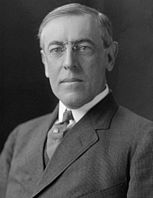1912 United States presidential election in Vermont
| |||||||||||||||||||||||||||||||||
| |||||||||||||||||||||||||||||||||
 County Results
| |||||||||||||||||||||||||||||||||
| |||||||||||||||||||||||||||||||||
| Elections in Vermont |
|---|
 |
The 1912 United States presidential election in Vermont took place on November 5, 1912, as part of the 1912 United States Presidential Election which was held throughout all contemporary 48 states. Voters chose 4 representatives, or electors to the Electoral College, who voted for president and vice president.
Vermont was won by the Republican nominees, incumbent President William Howard Taft, and his running mate Vice President James S. Sherman. Taft and Sherman defeated the Progressive Party candidates, former President Theodore Roosevelt and his running mate California Governor Hiram Johnson, and the Democratic nominees, New Jersey Governor Woodrow Wilson and Indiana Governor Thomas R. Marshall.
Taft won the state with a plurality of 37.13 percent, to Roosevelt's 35.22 percent, with Wilson in third place at 24.43 percent. Taft’s victory margin over Roosevelt was 1.91 percent.
Vermont historically was a bastion of liberal Northeastern Republicanism, and by 1912 the Green Mountain State had gone Republican in every presidential election since the founding of the Republican Party. From 1856 to 1908, Vermont had had the longest streak of voting Republican of any state, having never voted Democratic before, and this tradition continued in 1912.
Vermont was one of only two states (along with Utah) to vote for incumbent Republican President William Howard Taft, who was pushed into third place nationally by the strong third party candidacy of Theodore Roosevelt, a former Republican president who ran in 1912 with his own Bull Moose Party. Taft and Roosevelt split the Republican vote nationally in 1912, with Roosevelt coming in second place behind Wilson nationwide and carrying six states. However Vermont Republicans proved to be mostly loyal to President Taft as the official Republican nominee, allowing Taft to narrowly edge out Roosevelt to carry the state, leaving Wilson a distant third. Were Taft and Roosevelt voters united behind a single Republican candidate, they would have combined to over 72 percent of the vote in Vermont.
Vermont was the second most Republican state in nation in 1912, only beaten by Utah and New Hampshire[1]. However Taft's margin over Wilson was much greater in Vermont than in Utah or any other state.
Taft carried seven counties in Vermont to Roosevelt’s six, while Wilson won only tiny Grand Isle County in the far northwest of the state, with a plurality of less than 40 percent of the vote. This was the first time since Lewis Cass carried Washington County in 1848 that a Democrat had carried any of Vermont’s counties as well as the first time since Free Soil Party candidate John P. Hale won Lamoille County in 1852 that a third party candidate was able to win one of Vermont's counties and the most recent time doing so to date.
Results
| United States presidential election in Vermont, 1912[2] | |||||
|---|---|---|---|---|---|
| Party | Candidate | Votes | Percentage | Electoral votes | |
| Republican | William Howard Taft | 23,332 | 37.13% | 4 | |
| Progressive | Theodore Roosevelt | 22,132 | 35.22% | 0 | |
| Democratic | Woodrow Wilson | 15,354 | 24.43% | 0 | |
| Prohibition | Eugene W. Chafin | 1,095 | 1.74% | 0 | |
| Socialist | Eugene V. Debs | 928 | 1.48% | 0 | |
| Totals | 62,841 | 100.00% | 4 | ||
Results by County
| County | Taft | Votes | Wilson | Votes | Others | Votes | Total |
|---|---|---|---|---|---|---|---|
| Addison County | 45.3% | 1,835 | 15.3% | 621 | 39.3% | 1,591 | 4,047 |
| Bennington County | 36.1% | 1,464 | 26.1% | 1,057 | 37.8% | 1,534[3] | 4,055 |
| Caledonia County | 32.9% | 1,583 | 22.1% | 1,065 | 45.0% | 2,169 | 4,817 |
| Chittenden County | 36.8% | 2,368 | 35.2% | 2,266 | 28.0% | 1,801 | 6,495 |
| Essex County | 39.0% | 463 | 29.3% | 348 | 31.7% | 376 | 1187 |
| Franklin County | 33.2% | 1,433 | 30.5% | 1,317 | 36.4% | 1,571 | 4,321 |
| Grand Isle County | 31.0% | 193 | 33.8% | 210 | 35.2% | 219[4] | 622 |
| Lamoille County | 36.0% | 852 | 18.2% | 431 | 45.7% | 1,081 | 2,364 |
| Orange County | 34.2% | 1,289 | 25.4% | 956 | 40.5% | 1,525 | 3,770 |
| Orleans County | 36.4% | 1,475 | 15.5% | 628 | 48.1% | 1,952 | 4,055 |
| Rutland County | 36.0% | 2,999 | 25.0% | 2,079 | 39.0% | 3,246[5] | 8,324 |
| Washington County | 41.3% | 2,797 | 25.7% | 1,743 | 33.0% | 2,239 | 6,779 |
| Windham County | 38.3% | 2,143 | 23.7% | 1,327 | 38.1% | 2,132 | 5,602 |
| Windsor County | 37.5% | 2,409 | 20.3% | 1,302 | 42.3% | 2,716 | 6,427 |
References
- ^ "1912 Presidential Election Statistics". Dave Leip’s Atlas of U.S. Presidential Elections. Retrieved 2018-03-05.
- ^ "1912 Presidential General Election Results - Vermont". Dave Leip's Atlas of U.S. Presidential Elections. Retrieved 2013-08-02.
- ^ The leading "other" candidate in Bennington County, Progressive Theodore Roosevelt, received 1,380 votes, while Socialist candidate Eugene Debs received 105 votes, Prohibition candidate Eugene Chafin received 49 votes.
- ^ The leading "other" candidate in Grand Isle County, Progressive Theodore Roosevelt, received 204 votes, while Socialist candidate Eugene Debs received 9 votes, Prohibition candidate Eugene Chafin received 6 votes.
- ^ The leading "other" candidate in Rutland County, Progressive Theodore Roosevelt, received 2,927 votes, while Socialist candidate Eugene Debs received 240 votes, Prohibition candidate Eugene Chafin received 79 votes.




